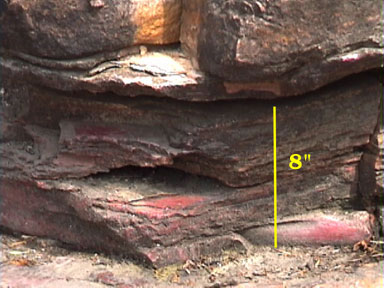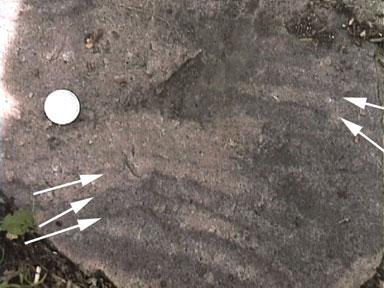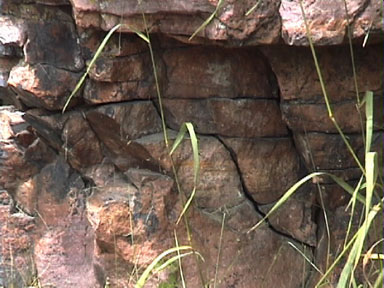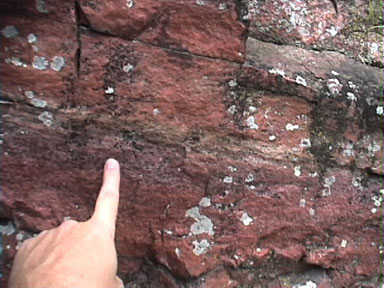The Pipestone
National Monument is a historic site managed by the National Park
Service.
The geology
of the area involves traditions and religious beliefs of Native
Americans.
The scientific name for Pipestone is catlinite after George Catlin, a
famous
nineteenth century painter (1)
who first made the rock and this area famous to other Americans.
| These photos are from a quarry pit
that is
open to the public at the end of Circle
Trail. The catlinite is only eight to eighteen inches
thick
and lies in a slightly angled bed sandwiched below about six feet of
Sioux
Quartzite of at this point and above another layer quartzite that is up
to 5000 feet thick. All of the quarrying must be done by hand
because
use of machinery would crush the catlinite and make it useless.
Only
about four to six inches of the layer of catlinite is useful for
carving
or making of pipes and that is often fractured so that slabs are seldom
more than two inches thick. It is the making of the "peace pipes"
that gave the stone its name. Click
here for more information on pipestone.
The stone is soft (about 2.5 on the
Mohs scale
compared to the quartzite of 7.5 above and below it), about the same
hardness
as a fingernail. It can be cut with steel saws or flint
drills.
The stone has the same hardness even when dry but freshly quarried
stone
feels soapy. When dry the stone becomes brittle and is more
difficult
to carve without shattering.
The stone is actually siltstone
containing
iron oxides to give it the red color. The stone bed dips at a
slight
angle to the east as you should be able to see in the photo at the
bottom
right. Some of the stone contains lighter colored spots giving it
the name Spotted Pipestone. Only Native American Indians with
proper
permits are allowed to quarry the stone. (2)
|
 |
 |
 |
The following table contains analysis of catlinite,
the
first by Dr. Jackson (Boston) of the red pipestone brought to him by
George
Catlin in 1836, the second from Dr. Ellestad (University of Minnesota )
for Berg in 1938.(2)
| water |
8.4% |
silica (silicon dioxide) |
49.01% |
| silica |
48.2% |
alumina (aluminum oxide) |
35.17% |
| alumina |
28.2% |
ferric oxide |
3.06% |
| magnesia |
6.0% |
magnesia (magnesium oxide |
0.23% |
| carbonate of lime |
2.6% |
calcium oxide |
0.05% |
| peroxide of iron |
5.0% |
soda (sodium oxide) |
0.06% |
| Oxide of manganese |
0.6% |
potash (potassium oxide) |
5.62% |
| loss |
1.0% |
water |
5.87% |
|
|
titanium dioxide |
0.44% |
|
|
lithium oxide |
0.16% |
|
|
ignition, less water |
0.24% |
| The quartzite in
this area was
deposited in a marine environment and was probably the result of
erosion
of granite since the feldspar in the granite weathers more easily than
the quartz. Evidence of the marine environment include ripple
marks
(arrows) in the quartzite. These ripple marks are formed the same
way that the ripples are formed on any beach. Looking closely at
the shoreline of a lake or the bottom of a sandy river you should be
able
to find similar ripple marks formed by the motion of the water.
By
measuring these ripple marks geologists are able to determine the
direction
the water was moving when the marks were formed. |
 |
 |
 |
 |
Following the circle
trail it
is easy to see why the Native Americans attached such a value to this
place.
In addition to the pipestone there is abundant vegetation, a water
falls,
a small pond in the stream and this large outcrop of quartzite.
The
quartzite pillar in the photos (left and below left) is called "Leaping
Rock". The early explorers Catlin and Joseph Nicollet saw
arrows
stuck in the rock. Traditionally a young warrior would leap this
chasm and place an arrow in the crack to prove his valor. Native
Americans across the country valued this area to such a great extent
that
this was a peace shrine. This is sacred ground where all
hostilities
must be forgotten and offerings must be made to the spirits that
protect
the valley. |
 |
 |
| The outcrops of the
quartzite
show the bedding process, including the dipping of the beds to the
east.
The colors range from almost white to brown, red and purple. It
is
easy to feel at peace here. The birds and small animals are
abundant,
the sound of the waterfall drowns out any small noises and even in the
summer heat the rocks offer a refreshing coolness. |
 |
 |
 |
 |
 |
The table below is an analysis of a quartzite sample taken from
Pipestone
(3)
| silicon dioxide |
84.52% |
calcium oxide |
0.31% |
| aluminum oxide |
12.33% |
magnesium oxide |
trace |
| ferric oxide |
2.12% |
potassium oxide |
0.11% |
| water |
2.31% |
sodium oxide |
0.34% |
1. Sansome, Constance Jefferson; Minnesota Underfoot,
1983,
p 116
2. National Park Service, Pipestone National Monument display
and brochure
3. Winchell, N. H. and Upham, W.; The Geological and Natural
History Survey of Minnesota, 1872-1882, p198
Back 

 Next
Next
Home
















 Next
Next